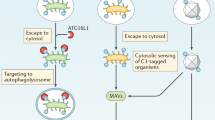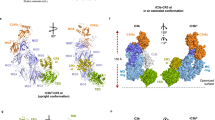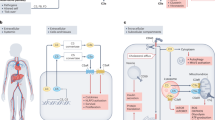Abstract
The human complement system is an important component of innate immunity. Complement-derived products mediate functions contributing to pathogen killing and elimination1. However, inappropriate activation of the system contributes to the pathogenesis of immunological and inflammatory diseases1. Complement component 3 (C3) occupies a central position because of the manifold biological activities of its activation fragments, including the major fragment, C3b, which anchors the assembly of convertases effecting C3 and C5 activation. C3 is converted to C3b by proteolysis of its anaphylatoxin domain2, by either of two C3 convertases. This activates a stable thioester bond, leading to the covalent attachment of C3b to cell-surface or protein-surface hydroxyl groups through transesterification3. The cleavage and activation of C3 exposes binding sites for factors B, H and I, properdin, decay accelerating factor (DAF, CD55), membrane cofactor protein (MCP, CD46), complement receptor 1 (CR1, CD35) and viral molecules such as vaccinia virus complement-control protein4. C3b associates with these molecules in different configurations and forms complexes mediating the activation, amplification and regulation of the complement response1,4. Structures of C3 and C3c, a fragment derived from the proteolysis of C3b, have revealed a domain configuration, including six macroglobulin domains (MG1–MG6; nomenclature follows ref. 5) arranged in a ring, termed the β-ring5. However, because neither C3 nor C3c is active in complement activation and regulation, questions about function can be answered only through direct observations on C3b. Here we present a structure of C3b that reveals a marked loss of secondary structure in the CUB (for ‘complement C1r/C1s, Uegf, Bmp1’) domain, which together with the resulting translocation of the thioester domain provides a molecular basis for conformational changes accompanying the conversion of C3 to C3b. The total conformational changes make many proposed ligand-binding sites more accessible and create a cavity that shields target peptide bonds from access by factor I. A covalently bound N-acetyl-l-threonine residue demonstrates the geometry of C3b attachment to surface hydroxyl groups.
This is a preview of subscription content, access via your institution
Access options
Subscribe to this journal
Receive 51 print issues and online access
$199.00 per year
only $3.90 per issue
Buy this article
- Purchase on Springer Link
- Instant access to full article PDF
Prices may be subject to local taxes which are calculated during checkout




Similar content being viewed by others
References
Volanakis, J. E. & Frank, M. M. The Human Complement System in Health and Disease (Marcel Dekker, New York, 1998)
Lambris, J. D. The multifunctional role of C3, the third component of complement. Immunol. Today 9, 387–393 (1988)
Law, A. S. K. & Dodds, A. W. The internal thioester and the covalent binding properties of the complement proteins C3 and C4. Protein Sci. 6, 263–274 (1997)
Kotwal, G. J. Poxviral mimicry of complement and chemokine system components: what’s the end game?. Immunol. Today 21, 242–248 (2000)
Janssen, B. J. et al. Structures of complement component C3 provide insights into the function and evolution of immunity. Nature 437, 505–511 (2005)
Feinberg, H. et al. Crystal structure of the CUB1-EGF-CUB2 region of mannose-binding protein associated serine protease-2. EMBO J. 22, 2348–2359 (2003)
Nagar, B., Jones, R. G., Diefenbach, R. J., Isenman, D. E. & Rini, J. M. X-ray crystal structure of C3d: a C3 fragment and ligand for complement receptor 2. Science 280, 1277–1281 (1998)
Zanotti, G. et al. Structure at 1.44 A resolution of an N-terminally truncated form of the rat serum complement C3d fragment. Biochim. Biophys. Acta 1478, 232–238 (2000)
Puliti, R. & Mattia, C. A. Ammonium N-acetyl-l-threoninate and methylammonium N-acetyl-l-threoninate. Acta Crystallogr. C 56, 496–499 (2000)
Gettins, P. G. Thiol ester cleavage-dependent conformational change in human α2-macroglobulin. Influence of attacking nucleophile and of Cys949 modification. Biochemistry 34, 12233–12240 (1995)
Winters, M. S., Spellman, D. S. & Lambris, J. D. Solvent accessibility of native and hydrolyzed human complement protein 3 analyzed by hydrogen/deuterium exchange and mass spectrometry. J. Immunol. 174, 3469–3474 (2005)
Xu, Y., Narayana, S. V. & Volanakis, J. E. Structural biology of the alternative pathway convertase. Immunol. Rev. 180, 123–135 (2001)
Becherer, J. D., Alsenz, J., Esparza, I., Hack, C. E. & Lambris, J. D. Segment spanning residues 727–768 of the complement C3 sequence contains a neoantigenic site and accommodates the binding of CR1, factor H, and factor B. Biochemistry 31, 1787–1794 (1992)
Clemenza, L. & Isenman, D. E. Structure-guided identification of C3d residues essential for its binding to complement receptor 2 (CD21). J. Immunol. 165, 3839–3848 (2000)
O’Keefe, M. C., Caporale, L. H. & Vogel, C. W. A novel cleavage product of human complement component C3 with structural and functional properties of cobra venom factor. J. Biol. Chem. 263, 12690–12697 (1988)
Koistinen, V., Wessberg, S. & Leikola, J. Common binding region of complement factors B, H and CR1 on C3b revealed by monoclonal anti-C3d. Complement Inflamm. 6, 270–280 (1989)
Higgins, J. M., Wiedemann, H., Timpl, R. & Reid, K. B. Characterization of mutant forms of recombinant human properdin lacking single thrombospondin type I repeats. Identification of modules important for function. J. Immunol. 155, 5777–5785 (1995)
Daoudaki, M. E., Becherer, J. D. & Lambris, J. D. A 34-amino acid peptide of the third component of complement mediates properdin binding. J. Immunol. 140, 1577–1580 (1988)
Bork, P., Downing, A. K., Kieffer, B. & Campbell, I. D. Structure and distribution of modules in extracellular proteins. Q. Rev. Biophys. 29, 119–167 (1995)
Krishna Murthy, H. M. et al. Crystal structure of a complement control protein that regulates both pathways of complement activation and binds heparan sulfate proteoglycans. Cell 104, 301–311 (2001)
Smith, B. O. et al. Structure of the C3b binding site of CR1 (CD35), the immune adherence receptor. Cell 108, 769–780 (2002)
Oran, A. E. & Isenman, D. E. Identification of residues within the 727–767 segment of human complement component C3 important for its interaction with factor H and with complement receptor 1 (CR1, CD35). J. Biol. Chem. 274, 5120–5130 (1999)
Lambris, J. D., Avila, D., Becherer, J. D. & Muller-Eberhard, H. J. A discontinuous factor H binding site in the third component of complement as delineated by synthetic peptides. J. Biol. Chem. 263, 12147–12150 (1988)
Aslam, M. & Perkins, S. J. Folded-back solution structure of monomeric factor H of human complement by synchrotron X-ray and neutron scattering, analytical ultracentrifugation and constrained molecular modelling. J. Mol. Biol. 309, 1117–1138 (2001)
Bernet, J., Mullick, J., Panse, Y., Parab, P. B. & Sahu, A. Kinetic analysis of the interactions between vaccinia virus complement control protein and human complement proteins C3b and C4b. J. Virol. 78, 9446–9457 (2004)
Ganesh, V. K., Smith, S. A., Kotwal, G. J. & Murthy, K. H. Structure of vaccinia complement protein in complex with heparin and potential implications for complement regulation. Proc. Natl Acad. Sci. USA 101, 8924–8929 (2004)
Tsiftsoglou, S. A. et al. The catalytically active serine protease domain of human complement factor I. Biochemistry 44, 6239–6249 (2005)
Smith, S. A. et al. Mapping of regions within the vaccinia virus complement control protein involved in dose-dependent binding to key complement components and heparin using surface plasmon resonance. Biochim. Biophys. Acta 1650, 30–39 (2003)
Otwinowski, Z. & Minor, W. Processing of X-ray diffraction data collected in oscillation mode. Methods Enzymol. 276A, 307–326 (1997)
CCP4. The CCP4 Suite: Programs for protein crystallography. Acta Crystallogr. D 50, 760–763 (1993)
Acknowledgements
We thank J. Chrzas for help with data measurement, K. Judge for technical assistance, the UAB Mass Spectroscopy Facility for mass spectra, and L. DeLucas for support. This research was supported by the NIH (H.M.K.M. and S.V.L.N.). G.J.K. is an International Senior Wellcome Trust Fellow for Biomedical Sciences in South Africa. Author Contributions K.G. and H.M.K.M. performed the crystallization and data measurement; A.A.A. and H.M.K.M. conducted the structure solution and refinement, and A.A.A., H.M.K.M., J.E.V., S.V.L.N. and G.J.K. performed the analysis.
Author information
Authors and Affiliations
Corresponding author
Ethics declarations
Competing interests
Coordinates and structure factors are deposited in the Protein Data Bank under accession number 2HR0. Reprints and permissions information is available at www.nature.com/reprints. The authors declare no competing financial interests.
Supplementary information
Supplementary Figure 1
Catalytic residues and Experimental electron density. (JPG 97 kb)
Supplementary Table 1
Data collection and refinement statistics (DOC 40 kb)
Supplementary Movie
A representation of the dynamics of C3 conversion to C3b and binding of the latter to microbial surfaces. (WMV 3471 kb)
Supplementary Legends
This file contains text to accompany the above Supplementary Figure and Supplementary Movie. (DOC 21 kb)
Rights and permissions
About this article
Cite this article
Abdul Ajees, A., Gunasekaran, K., Volanakis, J. et al. The structure of complement C3b provides insights into complement activation and regulation. Nature 444, 221–225 (2006). https://doi.org/10.1038/nature05258
Received:
Accepted:
Published:
Issue Date:
DOI: https://doi.org/10.1038/nature05258
This article is cited by
-
Retraction Note: The structure of complement C3b provides insights into complement activation and regulation
Nature (2016)
-
RNA Sequencing to Study Gene Expression and SNP Variations Associated with Growth in Zebrafish Fed a Plant Protein-Based Diet
Marine Biotechnology (2015)
-
Structure of a bacterial α2-macroglobulin reveals mimicry of eukaryotic innate immunity
Nature Communications (2014)
-
Hämolytisch-urämisches Syndrom und membranoproliferative Glomerulonephritis
Der Nephrologe (2011)
-
The impact of surfactant protein-A on ozone-induced changes in the mouse bronchoalveolar lavage proteome
Proteome Science (2009)
Comments
By submitting a comment you agree to abide by our Terms and Community Guidelines. If you find something abusive or that does not comply with our terms or guidelines please flag it as inappropriate.



